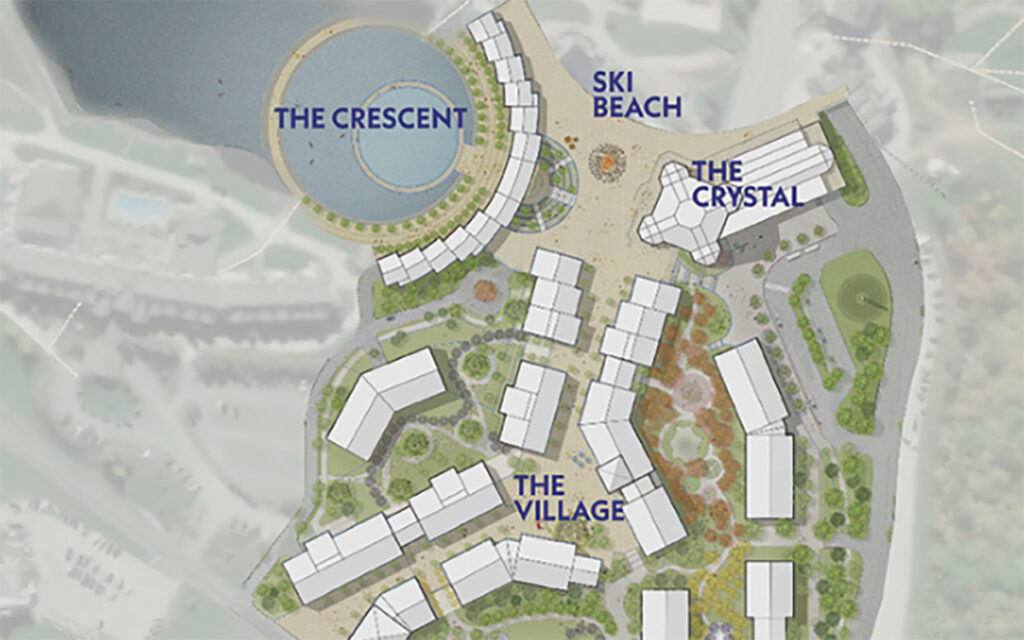By Kevin O’Connor/VTDigger
Developers of a proposed 450-acre retail and residential village at the base of the Killington Resort — the biggest ski area in eastern North America — say design changes will postpone the project for at least a year.
Announced last winter, the Great Gulf plans include a new lodge, some 32,000 square feet of commercial space, 193 condominiums and 32 single-family homes — the beginning, it said, of a larger $3 billion capital investment in the next quarter-century.
Developers had hoped to receive local and state approval for the first phase by this weekend’s World Cup ski competition at Killington. Instead, they’re now set to report a new timeline that will aim to seek permits in 2025, start construction as soon as 2026 and open the first buildings by 2028, according to Michael Sneyd, head of Great Gulf’s resort residential division.
“When people tell me, ‘How come you’re not in the approval process right now and why are you not showing us your latest plans?’ I tell them, ‘Good design takes time’,” Sneyd said. “The village will be the centerpiece, and so we really want to make sure we do the best job possible.”
A year ago, Great Gulf hired the international architecture firm of Moshe Safdie — whose work ranges from Montreal’s Habitat 67 World’s Fair housing complex to the Singapore Marina Bay Sands resort featured in the film “Crazy Rich Asians” — and PWP Landscape Architecture, known for the National Sept. 11 Memorial in New York City.
Planning paused when Killington, owned by the Utah-based Powdr Corp. since 2007, was purchased earlier this year by a group of local and regional investors that include Phill Gross, co-founder of Boston’s Adage Capital Management and a member of U.S. Ski & Snowboard’s investment committee; Michael Ferri, a Killington Mountain School trustee and partner in his family’s Valvoline Instant Oil Change franchises; and Great Gulf.
Killington’s new owners offered their opinions about the village, starting with a proposed central lodge that would replace the existing Snowshed and Ramshead buildings.
“The resort has come back to us recently and said, ‘Can we increase the size a little bit?’” Sneyd said, “and so that’s something we’re continuing to study.”
The developers also are working to retain a pond originally planned for partial elimination, to reroute vehicle traffic to make the village more pedestrian friendly and to add more areas for spring, summer and fall recreation.
The idea for a village dates back to 1958, when Killington Peak, Vermont’s second-highest summit, became a ski area. But decades of property and permitting issues have left blueprint upon blueprint sitting on the drawing board.
Great Gulf has yet to publicize a price tag for its overall retail and residential project or individual housing units, although it paid $43 million for the village land.
Local, regional and state economic leaders, for their part, have created a tax increment financing district that received town voter approval last year. A resulting “Killington Forward” package is funding more than $60 million in public road and water infrastructure improvements through grants, forgivable loans and tax increment financing.
Once developers revise their proposal, they’ll submit Phase 1 designs to the town’s development review board and a state district Act 250 land use commission, the latter which received the initial concept for a village in 1998 and went on to approve an earlier proposal in 2013 and, upon appeal, again in 2017.
Subsequent stages of the project could add up to 2,300 housing units over the next two to three decades, along with an estimated 1,000 contracting jobs and 1,200 permanent positions, according to recent paperwork submitted to the state.
Great Gulf estimates construction could average $118 million annually if the full quarter-century proposal is developed, but it would need to return to town and state reviewers for approval of future phases.
“Our goal is to make a ski village at Killington that is equal to the excellence of the mountain,” Sneyd said. “We want to make sure we make our first steps right so when we launch this project, it’s a big success from Day One and that will carry forward over the next couple of decades.”

Plans for a Killington ski village are underway at Ramshead.




